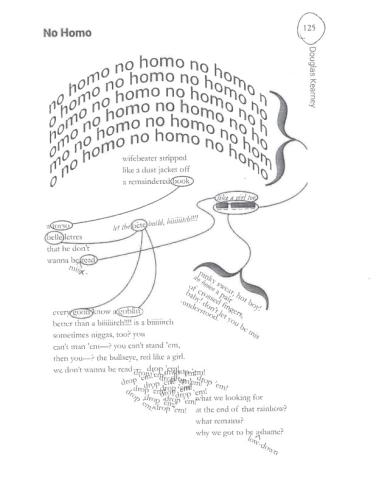By Sylvia Chan and Sarah Kortemeier
Students will use the refrain as a technique to help them explore their experiences of fear and of power, reflecting on how the two might be connected. The literary model for this lesson plan is Douglas Kearney's "No Homo."
Kearney, Douglas. "No Homo." SkinMag. N.p.: Deadly Chaps, 2012.
Preparation: Prior to the class field trip or virtual engagement with Voca, students have explored popular American protest music from the 1960s through 2010s and discussed imagery, lyricism, and representative themes, issues, motifs, and contexts. We defined and added to our definitions of the refrain—a repetition used in music, poetry, and writing to cultivate careful attention to sound. Sometimes, the refrain was in response to a call, an answer to a question, or even, an aftereffect.
In-Class Activity: At the Poetry Center, we listened to and discussed the poet-performer Douglas Kearney’s “No Homo” on the Poetry Center’s audiovisual Voca archive. Consider looking at the visual transcript of the poem and reviewing the listening to hear and to see how Kearney makes his line jumps, a play on “linguistic technology” that he attributes to Lil Wayne’s lyrics on language and masculinity.
Some guiding questions to help you move towards creating your Fear/Power poem:
- What are notable, outstanding, and unique images for you? What about lines/lyrics? Why?
- How does Kearney ask his target audience (who is?) to push beyond the layers of fear and contradiction beyond the phrase “No Homo?”
Your Fear/Power Poem should build upon our exercise:
- Think about a time you felt powerful: what did you hear, taste, see, smell, and/or touch?
- You can mix and match, rearrange and play with your variety of the five senses and layering of details.
- Think about a time you felt afraid: what did you hear, taste, see, smell, and/or touch?
- You can mix and match, rearrange and play with your variety of the five senses and layering of details.
- Pick a refrain, an image, line, or element that you want to repeat. Consider the act of refraining as well: what might you be holding back from? Why?
- Go to the library stacks and make a list of at least six (6) lines, titles, or combination of lines and titles from any books in the collection: find three (3) lines/titles for supporting your writing on fear and three (3) lines/titles for supporting your writing on power.
- Once you have at least six (6) lines/titles, start writing, building, rearranging, and revising your poem. Consider how Kearney rearranges or folds in certain language, almost like a physical umbrella unpacking the speaker’s thoughts and fears of being labeled queer. There are no restrictions on form; you can write however you feel best honors your fear and power poem.
- Don’t forget to title your poem. What are you, or your poem’s speaker, capturing about fear and power?
Type up and submit your Fear/Power poem, which should be about one page (or more).
Follow-up exercises (for next class period):
- Pick a favorite line(s) from the poem you wrote and use it as your jumping-off point. Write a paragraph or a few lines (3-6 sentences) inspired by your favorite line(s).
- Look at your refrain(s) and/or other forms of repetition. What else would you say to your target audience? Write a paragraph or a few lines (3-6 sentences) inspired by your refrain.



